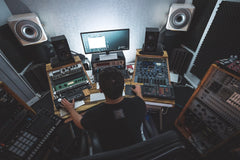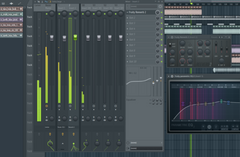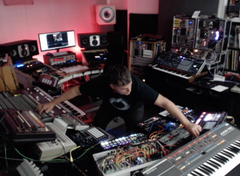Analog Effect Chains in Techno Production
How to build an analog effect chain?
In this article you will learn what the most essential analog effects are (Delay, Reverb, Chorus, Flanger, Distortion, Compressor) and how to set up an analog effect chain, especially for Techno and Dub Techno production. At the bottom you will also find some tips and techniques as well as helpful book recommendations.
Quite often up and coming producers ask me for advice which Eurorack modules they should get to start building a modular synthesizer. Their budget however is very limited in most cases and they can only afford one or two modules.
When I ask them further what they actually want to achieve they often mention an organic, warm, analog feel to their Techno productions and my best advice is getting a nice analog effect chain.
"Interesting sound design stands or falls on effects"
The most cost-efficient way to build an analog effect chain is to get some guitar stomp boxes and a small analog mixer. The mixer will allow you to set up a send-return effect chain and saturate the incoming signal and add some grit, you know, those overtones which are hard to achieve in software. But you can also saturate only the signal, which is sent to the stomp boxes or the wet signal coming back to the mixer. You will also be able to EQ the wet effect signal, which can give some extra deepness or emphasis on a certain frequency.
For the infamous Riemann Distorted Kicks sample packs I often used both techniques at the same time, I saturated a kick drum slightly with an insert effect (100% wet) and mixed in about 30% of an analog effect chain with a more aggressive distortion, mono reverb and lowpass filter. Sometimes even with another effect on top of this parallel processing, mainly a compressor or bit crusher. The advantage of this parallel processing approach is, that the low end from the original kick drum doesn't get destroyed by the distortion pedals, which sometimes tend to cut low and high frequencies!
"In Dub-Techno the effects are often more important than the sounds!"
Now let's talk about the effects itself, I would recommend to get 5 basic kinds of effects and create your very own, unique way of patching them and using your settings according to your taste. Even though there are thousands of different effect boxes, they always consist of only a few basic ingredients and everything else is a combination, modulation or interaction of them. So maybe avoid multi-effects for the start, also in order to fully understand the basic effects and how they can interact with each other.
In order to get started I would recommend to get those 6 kinds of effect boxes:
DELAY
You should have direct access to the delay time and feedback amount in order to change them on the fly and perform the effect according to the material you are treating. A tap button, which allows you to tap in the tempo of your track, e.g. 130Bpm, can be useful so you don't have to adjust the delay time by hand exactly to the desired amount.
If your sound source is mono, then go into the delay with one cable and go out with two cables and continue with stereo for the rest of the effect chain. Most guitar stomp boxes work in stereo, if you have one in mono however, put it before the stereo effects. The order can highly affect the sound of the chain, but it would be a waste of stereo "goodness" if you mix it down to mono again or take only the left or right channel at the end.
A classic device here would be the Boss Digital Delay.

REVERB
In nature, the space between single sounds, gets filled in various amounts by noise from the environment and mainly reflections, also known as reverb. Human beings are used to hear reverb all the times and can judge it extremely well, because it helps for our coordination as well as judgement of distances and surface materials.
In electronic music, where the sounds mainly come from oscillators or dry samples it is advised to add some artificial reverb. For metallic, warm and dull reverb effects an analog spring reverb will enrich the source sound and give it a deep organic feel. For the sake of getting you started with a good low budget solution, I would recommend a DSP (Digital Signal Processor) based reverb.
If you ask yourself why all those analog devices have digital innards so far, I can reassure you, that all stomp boxes are connected with analog cables and that the signal is converted multiple times from an analog signal to digital and back. This process adds some wanted flavor to the effect chain and sounds different to an effect chain emulation completely in the DAW (Digital Audio Workstation).
I did not say better, I said different. To my ears it does sound more exciting and organic.
A reverb effect unit should have a wet/dry amount control, a reverb time which can go up to 10 seconds minimum and a brightness amount, which enables you to filter down high frequencies.
A desirable reverb would be the Bluesky from Strymon, which is not the cheapest solution but when it comes to reverb I would spend most on that one in the chain.

CHORUS
This effect is highly recommended for stereo use, because chorus can add another dimension and vibrancy to a sound, especially when used at the end of the effect chain. It makes multiple copies of the signal, modulates them in pitch with an LFO (Low Frequency Oscillator) and delays them in variable small millisecond-amounts.
A very robust stereo chorus with all necessary parameters would be the TC Electronic Corona Chorus.
FREE Sample pack: 542 Techno Loops & Oneshots
Download in here: Free Sample Packs


FLANGER
This effect is similar to a chorus, but it can create the illusion of something rising up or falling down within a sound, if the modulation rate is slow enough. This very unique effect can quickly become too dominant and as a result annoying, but in small amounts it is able to add that extra movement to synth sequences and pads for instance.
My recommendation here is the MXR M-117, which is a high quality mono flanger and therefore should sit at the beginning of the effect chain. If you only work with stereo you would need to go for a stereo model of course, but rough sounds from a modular system are often mono anyways.

DISTORTION
This very dominant effect is able to shape and transform a sound into something completely different. The range of distortion and the different directions you can go with the source sound are extraordinary compared to subtile effects, like a chorus or flanger. Distortions are mainly used as an insert effect, but can also create impressive results if used less aggressive in send effect chains.
The most common types of distortion are:
- Overdrive, which is the softest and simulates a tube amplifier which runs at maximum volume. With this type of distortion the dynamics of the source sound are retained a bit better as it distorts more and more the louder the signal is.
- Distortion, which clips the signal at all times, no matter if its quiet or loud. This can change the perceived sustain of a sound, because if you didn't hear the full sustain of a synth line before, because it was so quiet, it will be audible and present after the distortion. This can be desired, but quite often it turns the synth sequence into one steady "sound sausage" and looses the percussive feel.
- Fuzz, which can create its own life and behavior because it folds and clips the waveform in extreme manners.
A lot of saturation can also be done within the analog mixer though, so if you want to leave out this effect, simply overdrive the mixer!
A rather subtile choice of distortion is the Friedman Dirty Shirley Ped. Overdrive, which simulates the distortion of an overdriven guitar amp. Very useful in this case are the controls for treble, mid and bass which allow you to highlight one or two of them and shape the effect return signal even further.
It should sit first in the send effect chain, because it would destroy some of the fine nuances in the sound spectrum of the enriched wet return signal.

So you can either choose to use your effect chain as an insert effect, which takes the signal from the sound source and processes it with the full amount or a certain percentage (if the unit has got a wet-dry knob). Or you build a send-return chain with a mixer, where you process the effect signal separately and bring it back together on the mixer in the desired amount and with an additional EQ on top.
COMPRESSOR
Compressors are dynamic effects, you can imagine it as a volume fader of a mixer, which goes down very fast when a loud signal comes in and goes up in volume when a low signal comes in. The purpose of this is to make the resulting signal louder afterwards. This effect sounds appealing to the humans, because it reproduces the effect of very loud music arriving to the ears - the physical nature of our hearing system cannot follow the full dynamics of sounds so we have a natural dynamic effect built in already.
Heavy usage of compression however can distort the signal so much that it becomes unattractive and smashed, the right ration is important here.
I would recommend to use the compressor at the end of a chain, because then you can highlight the more quiet reverb tails and fine nuances of the audio signal!
A classical compressor for an effect chain in the Boss CS-3, which is the latest Version of the, you guessed it right, CS-1. This model however is in mono, but there are some stereo models from other manufacturers around, or you go the premium way and route the signal into a proper 19" Rack compressor.

Guitar Stompbox Tricks & Techniques
- In Dub-Techno the effects are more important than the sounds! A dry dub-chord often sounds quite boring, the come alive through their effect chain. So for a Dub-Techno chord you can use a high-pass filter plus distortion as an insert effect (100% wet signal) directly after the synthesizer and drive the signal so it gets some more overtones. Then setup a send effect chain on the analog mixer with a stereo delay and chorus. This effect chain gives a typical dub-techno chord the depth it needs.
- To create a typical modular synth style Techno Sequence setup a send effect chain with a saturation, flanger and reverb. Even if the synthesizer comes from a digital source, the saturation will give it the edge and organicness it needs, because the louder sounds will trigger the distortion slightly different and give more or less overtones. This dynamic distortion will be heard even more through the reverb, because reverb can reveal and even amplify small details which are added through the saturation. The chorus should be used extremely subtile here to add just a nuance of depth. Mix the dry signal from the synthesizer with the effect signal so that both are present, but cut off some bass in the effect signal in case it became muddy and undefined.
- In the genres of Dub and Reggae, it is quite common to twist the send knob rhythmically, so that only short sections of the original sound enter the effect chain. This works very well on drums or vocals in minimalistic arrangements with loads of space between the sounds. Once a section of the source sound enters the send effect chain, the effect parameters can be performed - which can lead to some tripped out effect excesses and the effect itself can become the main element of a song.
- Another interesting technique is the side chain compression of an effect, which is best done in the DAW afterwards. Simply record the source signal and the effect return on separate layers and feed either the source sound into the side chain compressor on the wet effect signal, or send the kick drum on the compressor in a group channel of both, the wet and dry signal. This will create a pumping effect which can be very organic and pleasant in small amounts.
Book Recommendations
- Guitar Pedals (Mastering Guitar Effects)
- Audio Effects (Theory, Implementation and Application)
Written by Florian Meindl, last update 05. August 2019. Version 1.7

Subscribe to our Youtube channel for tutorials and free sample packs!



